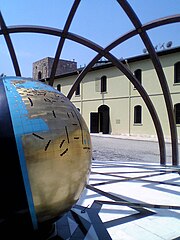Istanbul 2010 European Capital of Culture
 Istanbul has been designated as a "2010 European Capital of Culture" by the European Union. There are a lot of cultural things to see and do in Istanbul, but you would be hard pressed to find them from the official web site. Most useful is the calendar of events. See also my Istanbul by Public Transport.
Istanbul has been designated as a "2010 European Capital of Culture" by the European Union. There are a lot of cultural things to see and do in Istanbul, but you would be hard pressed to find them from the official web site. Most useful is the calendar of events. See also my Istanbul by Public Transport.There are two official documents. Unfortunately, while these must be magnificent in printed format, with high quality photos of the city, they are too large and cumbersome when translated into PDF documents. It is a shame some of this effort was not put into making a more usable web site. The official web home page had 255 HTML Validation errors and is not mobile friendly.
One document is the "Istanbul 2010 2010 European Capital of Culture Program". This is 137 pages of PDF (15 Mbytes):
CONTENTSThe second publication is the Istanbul 2010 Magazine (49 pages, 14 Mbytes of PDF):
INTRODUCTION / 4
Hayati Yazıcı / 6
Hüsamettin Kavi / 7
Sekib Avdagiç / 8
Yılmaz Kurt / 9
ISTANBUL 2010 ECoC OPENING ACTIVITIES / 10
ISTANBUL 2010 ECoC BRUSSELS LAUNCH / 12
OTHER EUROPEAN CAPITALS OF CULTURE FOR 2010 / 15
Pécs / 16
Ruhr / 18
ISTANBUL 2010 ECoC PROJECTS / 21
Vısual Arts / 22
Musıc / 40
Theatre and Performıng Arts / 62
Fılm Documentary Anımatıon / 76
Tradıtıonal Arts / 84
Internatıonal Relatıons / 92
Urban Culture / 108
Educatıon / 120
Lıterature / 126
Cultural Herıtage and Museums / 136
Urban Implementatıons / 150
Urban Projects / 166
Marıtıme / 184
Corporate Relatıons / 190
Promotıon / 198
Parallel Actıvıtıes Supported by Istanbul 2010 / 210
ISTANBUL GUIDE / 233
EVENT CALENDAR / 242
INDEX OF PROJECTS / 256
AGENDA
10 Cultural and art events calendar
14 Private museums
20 Interview HAYAT‹ YAZICI, Minister of State:
“2010 is the year in which change begins”
HERITAGE
28 Yenikap›: Istanbul 8,500 years ago
Discovering the future in the trails of the past
Tsunami and pickle effect
36 An ArcheoPark in Küçükyal›
40 Sur-i Sultani will be protected
The Story of the Strategic Plan for Sur-i Sultani
44 First city museum to be founded on the Islands
46 Interview ‹LBER ORTAYLI, President of Topkap› Palace Museum “2,000 Years of Common Heritage”
CITY'S ENERGY
50 Interview
OYA ECZACIBAfiI:
"Istanbul will be a stage for arts and life to act upon"
54 Interview PAUL MCMILLEN and HAKKI MISIRLIO⁄LU, creative directors of Istanbul 2010 ECOC Agency's domestic and international promotional campaings
60 Literature
40 books, 40 authors, 40 districts: “‹stanbulum”
64 Art is Everywhere!
Works and Lives in Istanbul
Portable Arts
Photography Parade
Kad›rga Art Production Centre
70 Cinema
1001 Istanbuls in My Binocular
Cinema Lies as the Heart of Istanbul
At›f Y›lmaz Studio
74 European Culture Award goes to “41º-29º ‹stanbul Network”
75 Istanbul’s Century-Long Transformation: 1910-2010 exhibition
76 Istanbul on the stage!
First Istanbul International Opera Festival
Seond Istanbul International Ballet Competition
Dance, theatre, music: Barbarossa
80 Classical Turkish Music is being archived
82 Inspired
84 Symbols of the City
90 Books and CDs on Istanbul
92 Leaving trails behind

EU Culture Capital is a well deserved honour, but curious as:
- There are three such capitals for 2010: the other two are Essen in Germany and Pécs in Hungary
- Istanbul is not a member of the EU
- Only half of Istanbul is geographically in Europe, the other half is in Asia.
Labels: Culture, Europe, European Commission, Istanbul




